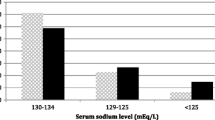Abstract
Background
Hyponatremia has significant prognostic implications in patients with heart, failure. However, little data are available regarding its significance in patients presenting with myocardial infarction. In addition, it is not known if correction of hyponatremia impacts outcomes in these patients. The aim of this study was to evaluate the prognostic value of hyponatremia in patients with myocardial infarction and the effect of its correction on all-cause mortality.
Methods
Patients with the discharge diagnosis of myocardial infarction at our institution between 2000 and 2010 with serum sodium levels measured within 24 h of admission were included in this retrospective analysis. Multivariate analysis was used to determine the predictors of all-cause mortality. Cox proportional hazard model was applied to determine the adjusted survival.
Results
A total of 11,562 patients (67.15 ± 14.6 years, males 56.3 %) were included in the analysis. There were a total of 1,535 (13.3 %) deaths within mean follow-up duration of 5.5 ± 3.3 years. There were 425 (27.9 %) deaths in patients with corrected hyponatremia and 155 (55.3 %) deaths in persistent hyponatremia patients. Multivariate analysis indicated that corrected hyponatremia and persistent hyponatremia were independent predictors of all cause mortality (p < 0.0001). When analyzing short-term (30 days) and long-term mortality, corrected hyponatremia group did not have associated long term mortality. Various methods to correct hyponatremia were also analyzed and use of vaptans was associated with decrease in mortality in patients with hyponatremia from 115 to 125 (HR 0.45; 95 % CI 0.26–0.78, p = 0.005).
Conclusion
Our analysis showed that corrected and persistent hyponatremia in patients presenting with myocardial infarction is a predictor of all-cause mortality, major adverse cardiac events and heart failure related 30 day rehospitalization. In certain cases, correction of hyponatremia may actually improve survival of the patients.




Similar content being viewed by others
References
Anderson RJ, Chung HM, Kluge R, Schrier RW (1985) Hyponatremia: a prospective analysis of its epidemiology and the pathogenetic role of vasopressin. Ann Intern Med 102:164–168
Cohen JP (2006) Cost-effectiveness and resource allocation. J Am Med Assoc 295:2723 author reply -4
Goldberg A, Hammerman H, Petcherski S et al. (2006) Hyponatremia and long-term mortality in survivors of acute ST-elevation myocardial infarction. Arch Intern Med 166:781–786
Waikar SS, Mount DB, Curhan GC (2009) Mortality after hospitalization with mild, moderate, and severe hyponatremia. Am J Med 122:857–865
Klein L, O’Connor CM, Leimberger JD et al (2005) Lower serum sodium is associated with increased short-term mortality in hospitalized patients with worsening heart failure: results from the Outcomes of a Prospective Trial of Intravenous Milrinone for Exacerbations of Chronic Heart Failure (OPTIME-CHF) study. Circulation 111:2454–2460
Gheorghiade M, Abraham WT, Albert NM et al (2007) Relationship between admission serum sodium concentration and clinical outcomes in patients hospitalized for heart failure: an analysis from the OPTIMIZE-HF registry. Eur Heart J 28:980–988
Movafagh S, Cleemann L, Morad M (2011) Regulation of cardiac Ca(2+) channel by extracellular Na(+). Cell Calcium 49:162–173
Havranek S, Belohlavek J, Skulec R, Kovarnik T, Dytrych V, Linhart A (2011) Long-term prognostic impact of hyponatremia in the ST-elevation myocardial infarction. Scand J Clin Lab Invest 71:38–44
Klopotowski M, Kruk M, Przyluski J et al (2009) Sodium level on admission and in-hospital outcomes of STEMI patients treated with primary angioplasty: the ANIN Myocardial Infarction Registry. Med Sci Monit Int Med J Exp Clin Res 15:CR477–CR483
Dargie HJ, Cleland JG, Leckie BJ, Inglis CG, East BW, Ford I (1987) Relation of arrhythmias and electrolyte abnormalities to survival in patients with severe chronic heart failure. Circulation 75:IV98–IV107
Mouallem M, Friedman E, Shemesh Y, Mayan H, Pauzner R, Farfel Z (1991) Cardiac conduction defects associated with hyponatremia. Clin Cardiol 14:165–168
AbouEzzeddine O, Prasad A (2010) Apical ballooning syndrome precipitated by hyponatremia. Int J Cardiol 145:e26–e29
Graham LN, Smith PA, Stoker JB, Mackintosh AF, Mary DA (2002) Time course of sympathetic neural hyperactivity after uncomplicated acute myocardial infarction. Circulation 106:793–797
Schaller MD, Nussberger J, Feihl F et al (1987) Clinical and hemodynamic correlates of elevated plasma arginine vasopressin after acute myocardial infarction. Am J Cardiol 60:1178–1180
Sigurdsson A, Held P, Swedberg K (1993) Short- and long-term neurohormonal activation following acute myocardial infarction. Am Heart J 126:1068–1076
Schrier RW, Abraham WT (1999) Hormones and hemodynamics in heart failure. N Engl J Med 341:577–585
Schrier RW, Berl T (1973) Mechanism of effect of alpha adrenergic stimulation with norepinephrine on renal water excretion. J Clin Investig 52:502–511
Xu DL, Martin PY, Ohara M et al (1997) Upregulation of aquaporin-2 water channel expression in chronic heart failure rat. J Clin Investig 99:1500–1505
Funayama H, Nakamura T, Saito T et al (2004) Urinary excretion of aquaporin-2 water channel exaggerated dependent upon vasopressin in congestive heart failure. Kidney Int 66:1387–1392
Sutton MG, Sharpe N (2000) Left ventricular remodeling after myocardial infarction: pathophysiology and therapy. Circulation 101:2981–2988
Yang XD, Zhao LY, Zheng QS, Li X (2003) Effects of arginine vasopressin on growth of rat cardiac fibroblasts: role of V1 receptor. J Cardiovasc Pharmacol 42:132–135
Wada K, Fujimori A, Matsukawa U et al (2005) Intravenous administration of conivaptan hydrochloride improves cardiac hemodynamics in rats with myocardial infarction-induced congestive heart failure. Eur J Pharmacol 507:145–151
Schrier RW, Gross P, Gheorghiade M et al (2006) Tolvaptan, a selective oral vasopressin V2-receptor antagonist, for hyponatremia. N Engl J Med 355:2099–2112
Holmes CL, Landry DW, Granton JT (2004) Science review: vasopressin and the cardiovascular system part 2—clinical physiology. Crit Care 8:15–23
Author information
Authors and Affiliations
Corresponding author
Rights and permissions
About this article
Cite this article
Qureshi, W., Hassan, S., Khalid, F. et al. Outcomes of correcting hyponatremia in patients with myocardial infarction. Clin Res Cardiol 102, 637–644 (2013). https://doi.org/10.1007/s00392-013-0576-z
Received:
Accepted:
Published:
Issue Date:
DOI: https://doi.org/10.1007/s00392-013-0576-z




